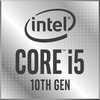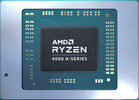Intel Core i5-1035G7 vs AMD Ryzen 5 4600HS vs AMD Ryzen 7 4800HS
Intel Core i5-1035G7
► remove from comparison
The Intel Core i5-1035G7 is a power efficient quad-core SoC for laptops and Ultrabooks based on the Ice -Lake-U generation that was announced in Mai 2019 (Computex). It integrates four Sunnycove processor cores (8 threads thanks to HyperThreading) clocked at 1.2 (base) - 3.7 (single core Turbo) GHz. 2 cores can reach 3.6 GHz and all four 3.3 GHz using Turbo Boost. According to Intel the Sunnycove cores achieve 18% more IPCs (Instructions per Clock). The Core i5-1035G7 is the second fastest Ice Lake-U chip at the time of announcement in 2019.
The biggest improvement for Ice-Lake is the integrated Gen 11 graphics adapter called Iris Plus Graphics. The Core i7-1065G7 integrates the biggest G7 variant with 64 CUs clocked at 300 - 1100 MHz. The Iris Plus G7 should be twice as fast as the predecessors and best the AMD Vega 10 GPU in current Ryzen APUs.
Other improvements for Ice Lake are the AI hardware acceleration and the partial integration of Thunderbolt and Wifi 6 in the chip. The integrated DDR4 memory controller supports modules with up to 3200 MHz (and LPDDDR4-3733).
Performance
The average 1035G7 in our database is in the same league as the Ryzen 3 4300U and the Core i5-10210U, as far as multi-thread benchmark scores are concerned. Which isn't bad at all as of late 2021. The Core i5-1035G4 and the Core i5-1035G1 are two other chips that nearly match the 1035G7 in multi-thread performance.
Thanks to its decent cooling solution and a long-term CPU power limit of 22 W, the Surface Laptop 3 13 is among the fastest laptops built around the 1035G7 that we know of. It can be at least 30% faster in CPU-bound workloads than the slowest system featuring the same chip in our database, as of August 2023.
Power consumption
This Core i5 has a default TDP (also known as the long-term power limit) of 15 W, a value that laptop manufacturers are allowed to change to anything between 12 W and 25 W if required with clock speeds and performance changing accordingly. Those values are a little too high to allow for passively cooled designs.
The processor is built with Intel's second-gen 10 nm process for decent, as of late 2022, energy efficiency.
AMD Ryzen 5 4600HS
► remove from comparison
The AMD Ryzen 5 4600HS is a mobile SoC for big laptops based on the Renoir architecture. The 4600HS integrates six of the eight cores based on the Zen 2 microarchitecture. They are clocked at 3 (guaranteed base clock) to 4 GHz (Turbo) and support SMT / Hyperthreading (12 threads). The chip is manufactured on the modern 7 nm TSMC process and partly thanks to it AMD advertises a 2x improved performance per Watt for the Renoir chips. Compared to the similar named Ryzen 5 4600H, the 4600HS is the power efficient version with a TDP of 35 Watt (10 Watt less).
Due to the two deactivated cores and the slower Turbo clock speed, the Ryzen 5 4600HS should be significantly slower than the Ryzen 7 4800HS. The old top model Ryzen 7 3750H is still clearly slower due to the four Zen+ cores. Compared to the competition, the Intel Core i7-8850H (6-core Coffee Lake 2.6 - 4.3 GHz) should offer a similar performance.
In addition to the six CPU cores, the APU also integrates a Radeon RX Vega 6 integrated graphics card with 6 CUs and up to 1500 MHz. The dual channel memory controller supports DDR4-3200 and energy efficient LPDDR4-4266 RAM. Furthermore, 8 MB level 3 cache can be found on the chip. See our hub page on the Renoir Processors for more information.
The TDP of the APU is specified at 35 Watt (default). Although the TDP is 10 Watt lower than the Ryzen 5 4600H, the chip is still intended for big and relatively heavy laptops.
AMD Ryzen 7 4800HS
► remove from comparison
The AMD Ryzen 7 4800HS is a mobile SoC for big laptops based on the Renoir architecture. The 4800HS integrates all eight cores based on the Zen 2 microarchitecture. They are clocked at 2.9 (guaranteed base clock) to 4.2 GHz (Turbo) and support SMT for a total of 16 threads. The chip is manufactured on the modern 7 nm TSMC process and partly thanks to it AMD advertises a 2x improved performance per Watt for the Renoir chips. The 4800HS is the 35 Watt version (-10 Watt) of the Ryzen 7 4800H.
In addition to the eight CPU cores, the APU also integrates a Radeon RX Vega 7 integrated graphics adapter with 7 CUs at up to 1,600 MHz. The dual channel memory controller supports DDR4-3200 and energy efficient LPDDR4-4266 RAM. Furthermore, 8 MB of L3 cache can be found on the chip. See our hub page on the Renoir Processors for more information.
Performance
The average 4800HS in our database is an impressively fast CPU that isn't afraid of picking a fight with the Intel Core i9-10980HK and the Core i7-11850H, as far as multi-thread benchmark scores are concerned. The Ryzen is fast enough for nearly all apps and games you could possibly throw at it, as of mid 2022.
Your mileage may vary depending on how high the CPU power limits are and how competent the cooling solution of your system is.
Power consumption
This Ryzen 7 has a default TDP, also known as the long-term power limit, of 35 W. Which is too high to allow for passively cooled setups.
The AMD Ryzen 7 4800HS is built with TSMC's 7 nm process leading to average, as of mid 2023, energy efficiency.
| Model | Intel Core i5-1035G7 | AMD Ryzen 5 4600HS | AMD Ryzen 7 4800HS | ||||||||||||||||||||||||||||||||||||||||
| Series | Intel Ice Lake | AMD Renoir (Ryzen 4000 APU) | AMD Renoir (Ryzen 4000 APU) | ||||||||||||||||||||||||||||||||||||||||
| Codename | Ice Lake-U | Renoir-HS (Zen 2) | Renoir-HS (Zen 2) | ||||||||||||||||||||||||||||||||||||||||
| Series: Renoir (Ryzen 4000 APU) Renoir-HS (Zen 2) |
|
|
| ||||||||||||||||||||||||||||||||||||||||
| Clock | 1200 - 3700 MHz | 3000 - 4000 MHz | 2900 - 4200 MHz | ||||||||||||||||||||||||||||||||||||||||
| L1 Cache | 192 KB | 384 KB | 512 KB | ||||||||||||||||||||||||||||||||||||||||
| L2 Cache | 2 MB | 3 MB | 4 MB | ||||||||||||||||||||||||||||||||||||||||
| L3 Cache | 6 MB | 8 MB | 8 MB | ||||||||||||||||||||||||||||||||||||||||
| Cores / Threads | 4 / 8 | 6 / 12 | 8 / 16 | ||||||||||||||||||||||||||||||||||||||||
| TDP | 15 Watt | 35 Watt | 35 Watt | ||||||||||||||||||||||||||||||||||||||||
| Technology | 10 nm | 7 nm | 7 nm | ||||||||||||||||||||||||||||||||||||||||
| max. Temp. | 100 °C | 105 °C | 105 °C | ||||||||||||||||||||||||||||||||||||||||
| Socket | BGA1526 | FP6 | FP6 | ||||||||||||||||||||||||||||||||||||||||
| Features | DDR4-3200/LPDDR4-3733 RAM, PCIe 3, 4 GT/s bus, DL Boost, GNA, MMX, SSE, SSE2, SSE3, SSSE3, SSE4.1, SSE4.2, AVX, AVX2, AVX-512, BMI2, ABM, FMA, ADX, VMX, SMEP, SMAP, EIST, TM1, TM2, HT, Turbo, SST, AES-NI, RDRAND, RDSEED, SHA, SGX | XFR, FMA3, SSE 4.2, AVX2, SMT | DDR4-3200/LPDDR4-4266 RAM, PCIe 3, MMX, SSE, SSE2, SSE3, SSSE3, SSE4A, SSE4.1, SSE4.2, AVX, AVX2, BMI2, ABM, FMA, ADX, SMEP, SMAP, SMT, CPB, AES-NI, RDRAND, RDSEED, SHA, SME | ||||||||||||||||||||||||||||||||||||||||
| iGPU | Intel Iris Plus Graphics G7 (Ice Lake 64 EU) (300 - 1050 MHz) | AMD Radeon RX Vega 6 (Ryzen 4000/5000) ( - 1500 MHz) | AMD Radeon RX Vega 7 ( - 1600 MHz) | ||||||||||||||||||||||||||||||||||||||||
| Architecture | x86 | x86 | x86 | ||||||||||||||||||||||||||||||||||||||||
| Announced | |||||||||||||||||||||||||||||||||||||||||||
| Manufacturer | ark.intel.com | www.amd.com |


 Deutsch
Deutsch English
English Español
Español Français
Français Italiano
Italiano Nederlands
Nederlands Polski
Polski Português
Português Русский
Русский Türkçe
Türkçe Svenska
Svenska Chinese
Chinese Magyar
Magyar
